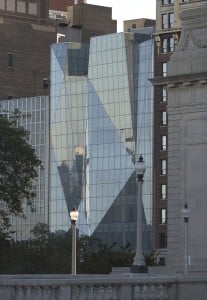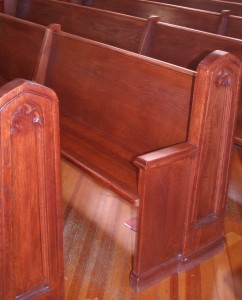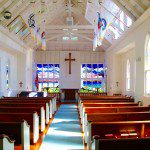
While the holy site I wrote about last, the National Museum of Mexican Art, is filled with brilliant hues, I found another holy site in Chicago that shines not with color, but with light.
I remember walking past the Spertus Institute of Jewish Studies on previous trips to Chicago, intrigued by its sleek, post-modern architecture. Its entire ten-story front wall is made of angled panes of glass, creating a mirror that reflects the beauty of Grant Park, Lake Michigan, and the Chicago skyline.
My friend Laurie Borman now works for the Spertus Institute, and so on my recent trip to Chicago I got a personal tour. “Our former building was very dark inside,” she explained, “and when this new building was envisioned, the architects were given one task above all: make it full of light.” The result is one of the architectural landmarks of Chicago, a building that has won numerous design awards. Appropriately, the Institute’s logo is a flame accompanied by the Biblical phrase yehi or—let there be light.
![spertus(1)[1]](https://wp-media.patheos.com/blogs/sites/628/2011/04/spertus11.jpg)

Spertus also has an array of historical and sacred objects displayed in an area called the Depot. I was most intrigued by the story behind an elaborately carved piece of wood (at right), a tale that I think reveals something important about the spirit of this place.
The piece is a synagogue place marker for the seat of the Vilna Gaon, an 18th-century Talmudic scholar who lived in Vilnius in Lithuania. “Gaon” means “genius,” a reflection of the man’s formidable intellect. Legend says that he was an expert in all five books of the Torah by the age of three. At eight, he was allowed to begin studying Kaballah, the mystical texts of Judaism, despite the fact that custom dictated that one must be at least 40 to do so. The Gaon believed that in order to understand Torah, one also needed to understand worldly subjects, and so he became learned in medicine, astronomy, and mathematics. Though he never became a rabbi, never held a public post, and never published any of his writings during his lifetime, he was renowned throughout Europe for his wisdom.
After his death, the people of his synagogue wanted to create a memorial to him, but synagogues (like mosques) are prohibited by religious law from including images of human beings. So they created a marker that hung on the wall over his place in the sanctuary and kept anyone from sitting in his seat—a reflection of the fact that no one could take his place.
The marker made me think of those people in my life who cannot be replaced, those whose warmth and love no longer grace my days. A lovely idea, isn’t it, to mark an absence in this way, with a piece of art that marks the place in our hearts that can never be filled again?
The Vilna of Gaon’s original marker was destroyed by fire, but it was re-built in 1868 and hung in its original place. This marker was found in the basement of the destroyed synagogue in 1944 and brought to Israel, eventually coming to Spertus in 1968.
And there it remains to this day, a testimony to the importance of learning and to the radiant intellect of a man who is still honored and remembered. It is a fitting tribute to have in the Spertus Institute, this house of figurative and literal light.















